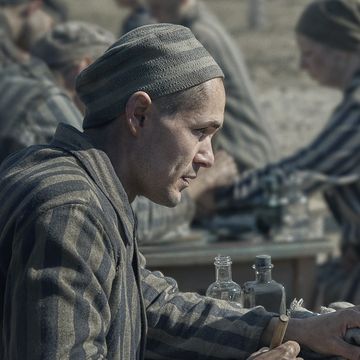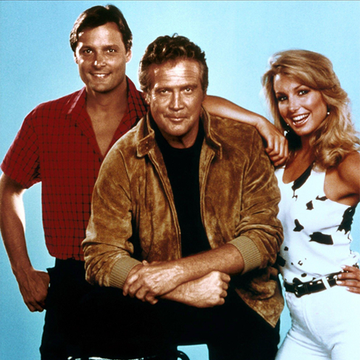W
e know what you’re thinking: what right does Esquire have to rabble-rouse about history's greatest video games? How do we even find time to play, amidst our packed daily schedules of tailoring appointments and swirling whiskey around tumblers?
Well that’s just the problem. These things are rarely written by casual gamers, and too often lack underrated gems that the playing public love. To rectify that wrong we decided to pull together this list, unfettered by critical dogma, esoteric grandstanding and so-called expertise.
Without further ado, here are 20 of the best video games of all-time (but, you know, actually)...
PlayStation 2, GameCube, PC, 2003
We’ve all been burned by games adapted from beloved films: think of the Fight Club game considering an unlockable avatar of Limp Bizkit’s Fred Durst a reward for successfully duffing people up. Lord of the Rings: Return of the King was different though, pulling out all the stops to make you feel a part of Middle Earth.
Most importantly, the classic arcade-indebted slice-and-dice fighting style made hacking your way to Mount Doom feel like a right laugh, and while murdering hordes of orcs and urukhai was satisfying on its own - hack, stab, slash, panic, hope Gandalf saves you by firing his magic rocket launcher - it was the co-op mode which made Return of the King great. Stopping the forces of evil overrunning Middle Earth wasn’t really the point of the game – the aim was to try to rack up more kerb-stomped evildoers than your mate, to the point of stealing their kills and much-needed health potions, and thereby jeopardising the mission and the fate of the Shire. Its authentically built world and the frankly ludicrous density of competitive pummelling made you feel like you were on the front line at Helm’s Deep.
PC, 2002
The scope of this World War 2 shooter was unprecedentedly vast: campaigns spanned France, Germany, the Eastern Front, North Africa and the Pacific, and melded straight-up Nazi-hunting larks with big-picture strategising. As your CPU comrades’ IQ levels ranged between that of an upturned mop bucket with a face drawn on it at the low end and that of a particularly kamikaze four-year-old at the high end, the real fun was online.
Turning away from the standard first-person romp toward Berlin which implied that you – yes, private, you! – were the one thing stopping Hitler from goose-stepping down Whitehall, the basic aim of building points by holding key tactical positions with your comrades meant you needed to collaborate, plan and use your imagination to stem the danger and gradually turn the tide of battle. The array of vehicles to play with – Jeeps, tanks, fighter planes, bombers, landing craft, battleships, even aircraft carriers – meant that there was always another skirmish to launch into and no battle was ever quite the same. There’s still a hardcore community of fans playing it online now, 16 years on from its release.
Wii U, Nintendo Switch, 2014
Donald Trump’s spore-bearing bellend as a playable character aside, Mario Kart 8 is the greatest racing game of all-time. While the Wii instalment – with its Early Learning Centre wheel and much-heralded motion controls – felt like pure wish fulfilment, the Wii U follow-up marked the moment that Mario Kart truly power-drifted away from its competitors.
Pixel-revving petrolheads disagree, of course. They like hyper-realistic racing sims like Gran Turismo, where you can painstakingly tinker with shiny branded sports cars, career around world-famous tracks and slam endlessly into 4k-rendered metal barriers – but Mario Kart has always been far more serious than any of that. It’s a tactical game that ironically rests largely on luck, best summed up by a perfect race, a last-second blue shell and an infuriating 5thplace finish. Your average racing game delights in punishing and frustrating part-timers, but Mario Kart gets its kicks from ruthlessly beating down on the leaders of the pack. It’s that obsession with levelling the playing field which makes it such perfect, friendship-straining multiplayer fodder.
PlayStation 2, Xbox 360, PC, 2006
Let’s get one thing straight: in the mid-00s, FIFA was for nerds and Pro Evolution Soccer was for devil-may-care libertines. That’s a fact. Pro Evo purists have their own favourite edition, but PES6 had it all. The gameplay was in the sweet spot between the entertainment-first arcade style of later PS2 versions and the tiki taka-rewarding pass-and-move of the earlier games, which made for enjoyably berserk end-to-end pinball. More than anything else, though, it was endearingly mad.
While the detail-heavy FIFA franchise was busy chasing a smooth, mannered, televisual style, PES6 went violently the other way and made a day-glow rave-up of a football sim. Superhuman stats? Have Adriano’s 99-rated shot power! You want to piss about and play with a team of literal dogs? Sure buddy, swap your back three’s heads with a chihuahua, a pug and a bulldog! PES6 knew that during a late night session you want the equivalent of a muddy, pell-mell 25-a-side down the park, and was the better for it.
Game Boy, 1989
The story behind Tetris is a bit of a downer. Alexey Pajitnov, an AI researcher working for the Soviet Academy of Sciences in Moscow, created the puzzler in June 1984 and shared it with his colleagues. It soon stretched around the city, spread across Europe and eventually the world – which would have made the bearded Russian a very rich man, if it wasn’t for the fact that the Communist Party of the Soviet Union were tracking its popularity and quickly stole the sales rights.
The computer engineer only started to get royalties for the title in 1996, long after Tetris fever had died down. We don’t feel too bad for his bank balance, though: the puzzler has endured for over three decades thanks to its addictive simplicity, and slots seamlessly into the mobile gaming revolution, where it typically sits next to Candy Crush and a grid of other gaming phenomenons it directly inspired.
PlayStation 2, 2002
‘Cinematic’ wasn’t a word you could use with too many games before GTA: Vice City, but the vast and detailed Miami-a-like backdrop to this tale of gangland drug deals and violence redefined how big a gameworld’s scope could be. The effort which went into the world-building was staggering, whether you were exploring the vast, living streets or just cruising around town listening to one of nine pitch-perfect radio stations.
Its satire wasn’t subtle (a gun shop called Ammo Nation, how droll...) but lampooning the excesses of late-Reagan era America meant it could also purloin its slick, neon-lit aesthetic, which in turn helped to rescue an entire era from the depths of naffness. Would we have had Drive or the San Junipero episode of Black Mirror without Vice City?
A moral panic over Rockstar's depiction of fighting between different ethnic groups and its ultraviolent gameplay only heightened the sense that this was a piece of culture which showed how much video games had widened the generation gap. Guardians of taste saw a blood-soaked interactive video nasty straight from the grindhouse; gamers saw a deeply ironic, subversive, multi-layered world which skewered American excess and arrogance.
PC, 1997
“You have just killed your first patient. How does it feel?” asks the sarky little scientist squatting in the bottom right corner of Theme Hospital. It's a good question, but there's no time to dwell on existentialisms when a pesky rat infestation is gnawing its way through your pricey machinery.
Wait, why is there so much vomit in the waiting room? Because you forgot to hire any cleaners, idiot.
Wh.. what the hell is wrong with that man’s face? Whatever it is, none of your underqualified, underpaid, ne'er-do-well doctors can help, so send him packing. Before long, the sanctity of human life takes a back seat to balance sheets, and the gallows humour of the game infects your very soul. Life simulation games like The Sims always manage to bring out our inner-psychopaths, but no game entwines those deepest, darkest impulses with the morbid realities of capitalism quite like Theme Hospital.
PlayStation, Nintendo 64, Xbox, 2000
Video games are fundamentally about fulfilling a fantasy. Manage your beloved Walsall to Johnstone’s Paint Trophy glory, launch yourself around Manhattan as Spider-Man, drive an 18-wheeler from Newcastle to Budapest while meticulously observing traffic laws: you can do it all. However, no game has answered a vague yearning so completely and satisfyingly than Tony Hawk's Pro Skater 2.
If we’re honest, as cool as skateboarding looks, most right-thinking people don’t really fancy forfeiting their knee tendons while attempting the most basic ollie. Tony Hawk 2, though, wrapped up every aspect of American skater culture – clothes, icons, pop-punk and nu-metal soundtrack – around a gameplay dynamic which could convince even the most equilibrium-challenged gamer that yes, you could totally nosegrind around rails in an abandoned hangar before launching yourself into a 540-degree Benihana.
It was all down to a set of controls which would let a novice merrily button-mash their way through a level and come out with some dignity, but which experts could weave into endless combos and specials. The soundtrack probably gave Papa Roach a longer lifespan than they deserved, but don’t hold that against the game.
Mobile
It’s slightly strange that the game which almost singlehandedly popularised mobile gaming – an industry so pervasive and profitable that they now sponsor Premier League teams’ shirt sleeves – was so overtly retro. The basic concept of Snake (move a line of dots around a 2D map, make it eat another dot, try not to hit your tail or the edge of the map) has been around since the 1976 arcade cabinet Blockade and kept bubbling back up throughout the 80s and 90s for different developers, like a gaming equivalent of Sherlock Holmes.
It didn’t have the broader impact of Pac-Man or Donkey Kong, but that changed when it was bundled with the 126 million unit-selling Nokia 3310 in 2000. Your mum had one, your granddad had one, your mates at school had one, and Snake’s simple and addictive gameplay vaulted over generation gaps with ease. It popularised the idea of combining a mobile phone with a console, taking gaming out of the teenager’s bedroom and put it in the hands of everyone who was ever bored in a dentist’s waiting room or needed something to keep their kids occupied while they had a lie-in. Literally a game-changer. Literally.
PlayStation, PC, 1996
The advent of platformers thoroughly embarrassed the simplicity of the point-and-click adventure: there was nothing exciting about text-based story interspersed with the quiet swish of a mouse movement. At least that was the case until 1996’s Broken Sword: Shadow Of The Templars - the first instalment of the long-running series that reignited the flame of the format. We met a thoroughly earnest American hero in George Stobbart, killer clowns, the Illuminati, a French love interest and a dangerous divine power that could destroy the world. Sure, it’s very much of its time, but Shadow Of The Templars set the precedent for blockbuster plots and high-octane cut scenes.
Game Boy Colour, 2000
Nobody actually played the Pokémon Trading Card Game, which was basically Top Trumps with pebbles and ideas above its station. The videogame, though? That probably found its way onto every Game Boy in existence. It’s the second best-selling franchise of all-time after all, behind Mario and his 15-year head start, and the modern generations have barely strayed from the original Red and Blue-print.
Is it possible to pick a best one? In an attempt to be totally objective and unbiased, I judged each version against how old I was when I played it and a bunch of other inane benchmarks. Ultimately 2001’s Crystal, the enhanced version of Gold and Silver, won out thanks to its updated Pokemon roster (251, before the quality dipped and the list spiralled out of control), its introduction of (now outdated) gender options, the time-siphoning battle tower, and the fact I was 10 year’s old at the time (that’s prime Pokémon playing age).
Nintendo 64, 1996
There’s a melancholy coursing through Super Mario 64 that’s absent from most of the series (bar Mario is Missing!, the downright unnerving SNES edu-tainment title). Maybe it’s the countless hours spent running around an empty castle with only paintings and a few scattered, unblinking toads for company. Maybe it’s the synthy, pan flutey soundtrack. Whatever it is, I still can’t swim around Jolly Roger Bay without staring at a wall for a few hours afterwards.
Am I projecting? It certainly looks that way, and I’m sorry for making things weird – but the fact remains that Mario 64’s ground-breaking 3D open world had a profound emotional effect on players across the globe, and somehow continues to do so, regardless of how tiddly it now seems in comparison. Combine that with the almost unbearable nostalgia factor, and you’ve got yourself a top existential crisis.
Nintendo 64, 1997
Nobody expected much of GoldenEye 64. It was a film license game after all, destined to become a hastily and lazily produced cash-in on the James Bond franchise. That it went on to become one of the greatest and most influential videogames of all-time is a testament to an overworked team of 10 developers and the inexperience that bolstered their ambition.
“Because it was most people’s first game, we did things we might not do again,” said Rare staffer Graeme Norgate. “If something sounded like a good idea, it was like, ‘Yeah, let’s do it! The world was our oyster! Only afterwards would you find it was a world of pain.” When it comes to multiplayer, GoldenEye stands jagged head and long, pointy shoulders over every first-person shooter that came after it. Why? Because it involves getting your actual mates together on a settee to launch grenades at each other, rather than just getting relentlessly headshotted by racist 10-year-olds online. That’s no life, really.
PlayStation 3, Xbox 360, PC, 2011
Before Arkham Asylum soared glumly onto the scene in 2009, the superhero genre was haunted by the memory of one game: 1999’s Superman 64. A title so irredeemably bad, so fundamentally broken and unplayable, that it often ranks as the worst videogame of all-time. While that may not be completely fair (especially in a world where litter-picking simulator ‘Universal Studios: Theme Park Adventure’ exists), it deservedly became the prime example of all that was wrong with lazy superhero cash-ins. The millennium brought about an unexpected golden-age for the film genre, but their console spin-offs continued to disappoint.
The Arkham series changed all that, with its pitch-perfect tone, rich script, deeply satisfying fighting/flying mechanics and endless references to deep cut comic book lore. For the first time players actually felt what it was like to become Batman, the scowling super emo with the unwavering ethical compass that allows him to pummel henchmen to mush as long as they’re still technically alive. Within the acclaimed trilogy, Arkham City reigns supreme.
Nintendo Switch, 2017
If someone asked you to name the greatest Zelda game, you’d probably feel pressured to say Ocarina of Time. Maybe you’d choose Majora’s Mask, just to be difficult. But can either of those N64 classics really hold a candle to 2017's Breath of the Wild? Can any other game, for that matter? With its vast and varied landscapes, epic battles, touching storyline and myriad side quests, the Switch title feels like the ultimate fulfilment of a vision that stretches back decades.
Parts of BOTW that should be annoying and repetitive – the lifeless plains you spend most of your time wandering across, the rickety weapons that break apart with only a few jabs, the back-and-forth nature of certain tasks – just adds to the meditative quality of an adventure that often values patience and contemplation over skill, and truly heightened what an ‘open world’ game could ever hope to be.
PC, Xbox 360, PlayStation 3, 2007
Before it became an international sensation that introduced PC gaming to a whole new generation of players, sci-fi puzzler Portal was just a bit of padding for The Orange Box Collection. Squashed between Half-Life 2 and Team Fortress 2, developers Valve limited the game’s length because they had no idea what punters would even think of it. Word of mouth and gushing reviews, mostly praising its dark, deadpan wit and ingenious conundrums, meant that it soon took centre stage, winning copious awards and inspiring a huge online community of dedicated fans and modders.
PlayStation, 1998
Beautiful console blockbusters like The Last of Us, Mass Effect and the Uncharted series have successfully blurred the line between video games and cinema, but it was the 1998 PlayStation classic Metal Gear Solidand Hideo Kojima, the revolutionary auteur behind it, that proved such a feat could be accomplished.
It was the first game to properly utilise cut scenes to drive the story (which touched on a range of real-life issues, including the threat of nuclear holocaust and PTSD) forward, and it was the only game around that even tried to rival cinema in its production values. That’s not to mention the fact that it single-handedly introduced the (albeit, now overused) ‘stealth’ format to the gaming world. Looking at the filmic direction in which the industry is heading, it’s hard to think of a more influential release than MGS.
PC, 1990
In games, as in life, man only wants one thing: and that’s the ability to store infinite objects in our trousers. Guybrush Threepwood’s magical (and stylish) pantaloons contained everything and anything you could need for this point-and-click pirate adventure, notable for the fact that it’s near impossible to lose. Sure, you can get stuck and frustrated as you try to find a use for a rubber chicken with a pulley in the middle, but it’s pretty hard to actually perish or get a “game over” screen. From the Coke-inspired Grog machines to ingenious insult-based sword fighting, Monkey Island is a much an achievement in comedy and satire as it is in gaming.
iOS, Android, 2016
A lot of gaming classics could reasonably be classed as ‘global phenomenons’, but how many of those titles actually had a genuine impact on humanity, beyond bruised thumbs and square eyes? Only Pokémon GO, Niantic and Nintendo’s augmented reality phone app, can lay claim to that.
Almost immediately after its release in the summer of 2016, millions of strangers across the world stepped on to the streets and actually talked to each other, all for the sake of a few levitating pixels. Out of nowhere, our smart phones started to function as a driving force towards new human interaction, rather than as a tool to desperately avoid it. It didn’t just get people gabbing, but it got them moving too, exploring the nooks and crannies of their cities for the first time and getting some much-needed exercise in the process (which, admittedly, didn’t always end well).
As the summer came to a close and the cold set in, Pokémon Go downloads plummeted – but we’ll always have those strange few months, spent huddled around a park bin with a bunch of random Spanish tourists, trying to catch a Rattata. After all is said and done, maybe the greatest game of all, dear readers, is friendship.
Where were you when it happened? You know what we're talking about. Sephiroth - sword between his fists, dirty white hair flailing in the wind - landing directly between the shoulder blades of your first true love - OK second maybe, after Kelly from Saved By The Bell - the beautiful, innocent Aerith. Over she slumps, folded in the twilight, and you, a kid in a bedroom somewhere ignoring the news your tea was ready, would never be the same again.
For a certain generation, the story of Cloud and his merry band of rebels escaping the city of Midgar was a story as defining as any film, book or TV show of the 90s. Final Fantasy VII introduced the concept of open world game play to the Playstation generation and featured graphics of a quality beyond anything that had ever gone before. But it was the complexity of FF7's story, the definitive proof it offered of video game as art form - take that cynical parents! - that embedded it in our hearts.
A bit like Sephiroth's sword was embedded in Aerith's heart, come to think of it. Not that we're still not over it, or anything.

Nick Pope is the Site Director of Esquire, overseeing digital strategy for the brand.


















